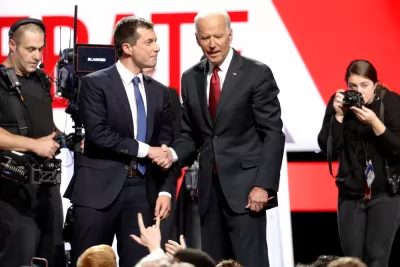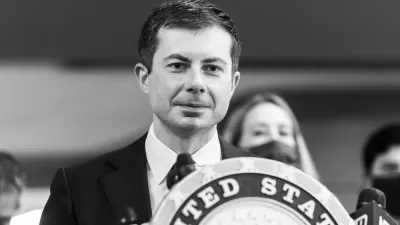You just got the top transportation job in the country. What are your priorities? Who are your allies? And one last question: Do you even want the job?

The impossibly improbable has occurred and you're the new transportation secretary.
Fifty-five thousand employees are waiting for their marching orders. Transportation “leaders” around the country – some rooting for your demise – watched your senate confirmation, all the flashy talk about reducing carbon, racial equality, and an economy that works for all. But talk is cheap, and they are ready to dissect and exploit your every move.
So what do you think about U.S. transportation?
You inherited your predecessor's office furniture and an $87 billion budget when Congress extended the FAST Act another year. But large chunks of the department's budget, including much of the nearly $47 billion allocated for roads and public transit are controlled by funding formulas set by Congress.
And that is precisely why your new boss hired you. He didn't pick a fly on the wall. Significant overhaul of the nation's infrastructure—which has become a perennial joke on Capitol Hill—will require significant negotiation with federal lawmakers.
But the shot clock is ticking. Democrats control the White House and both chambers of Congress, but pushing through your boss's $2 trillion infrastructure reform plan will be difficult if it doesn't happen this year, when midterm elections in 2022 could change your odds.
So who do you turn to?
You scratch your head, but it's obvious. You immediately dial-up Representative Peter A. DeFazio of Oregon, the top Democrat on the Transportation and Infrastructure Committee. He takes your call because he likes your boss. You have him over for dinner. The conversation and booze flow effortlessly.
Yet your next call and dinner party isn't as enjoyable. Senator Bill Hagerty, a Republican of Tennessee, was one of 13 senators to vote against you. He told everyone that you will "use the department for social, racial and environmental justice causes," instead of focusing on "streamlining environmental reviews for projects or other deregulation efforts."
So your hands are about to get dirty. Do you win Mr. Haggerty and his 12 amigos over by funding a rural highway-on-ramp in nowhere Tennessee, even though that will increase car use? Could be worth it.
Meanwhile, those other 'leaders" I mentioned won't stop pounding your door, reminding you that transportation is the biggest contributor to greenhouse gas emissions, and the Paris agreement your boss cares about is hopeless if you don't clean up U.S. transportation.
And others bust your chops by waving studies that conclude commuting time has emerged as the single strongest factor in the odds of escaping poverty and building a better life—a bigger factor than crime, test scores in schools, or living in a two-parent home.
Still, others call the climate crisis a hoax and accuse you and your leadership of being the real crisis.
But you have money you can use to make real changes immediately, including the department's $1 billion BUILD grant program that funds road, rail, transit, and port projects across the country. Your office controls the criteria that determine what project proposals are competitive for funding, and transportation secretaries from both parties have historically used this program to follow through on their priorities.
Speaking of which, what are your priorities?
Are you going to encourage bike lanes and bus travel?
Are you going to support sidewalks in distressed neighborhoods or cheaper transportation costs for low-income workers?
And one final question: Do you still want the job?
This article is inspired by Alan Guebert's February 7 column. Alan is an award-winning agriculture journalist, and if you don't already subscribe to the Farm and Food File or his tweets, you haven't lived. He makes reading about U.S. agriculture fun.

Planetizen Federal Action Tracker
A weekly monitor of how Trump’s orders and actions are impacting planners and planning in America.

Congressman Proposes Bill to Rename DC Metro “Trump Train”
The Make Autorail Great Again Act would withhold federal funding to the system until the Washington Metropolitan Area Transit Authority (WMATA), rebrands as the Washington Metropolitan Authority for Greater Access (WMAGA).

DARTSpace Platform Streamlines Dallas TOD Application Process
The Dallas transit agency hopes a shorter permitting timeline will boost transit-oriented development around rail stations.

Parks: Essential Community Infrastructure — and a Smart Investment
Even during times of budget constraint, continued investment in parks is critical, as they provide proven benefits to public health, safety, climate resilience, and community well-being — particularly for under-resourced communities.

Porches, Pets, and the People We Grow Old With
Neighborhood connections and animal companions matter to aging with dignity, and how we build can support them. Here’s a human-scale proposal for aging in place.

Single-Stair Design Contest Envisions Human-Scale Buildings
Single-stair building construction is having a resurgence in the United States, where, for the last several decades, zoning codes have required more than one staircase in multi-story housing developments.
Urban Design for Planners 1: Software Tools
This six-course series explores essential urban design concepts using open source software and equips planners with the tools they need to participate fully in the urban design process.
Planning for Universal Design
Learn the tools for implementing Universal Design in planning regulations.
City of Charlotte
Municipality of Princeton
City of Camden Redevelopment Agency
City of Astoria
Transportation Research & Education Center (TREC) at Portland State University
US High Speed Rail Association
City of Camden Redevelopment Agency
Municipality of Princeton (NJ)



























